The red 'CABIN DIFF PRESS' warning message is displayed. What does it mean?
To minimize noise in the flight compartment and cabin, when the RECIRC AIR switch is selected to AUTO, the recirculation fan will be inhibited or turned off automatically when the aircraft is on ground with APU bleed, dual pack operation, and when OAT is:
To reactivate the fan, the PACK FLOW switch on the AIR panel must be selected to HI.
The Negative Pressure Relief Valve (NPRV) is on the aft pressure bulkhead. It has a:
The air-conditioning system uses hot bleed air from the engines or the Auxiliary Power Unit (APU). This air is converted by the air-conditioning PACKS for ventilation, cooling, heating, and pressurization of the cabin, flight compartment, and cargo compartments.
The FWD CARGO switch on the AIR panel is used to control the temperature in the forward cargo compartment. It has three settings: LO HEAT, HI HEAT and VENT. The LO HEAT setting maintains a cargo temperature between:
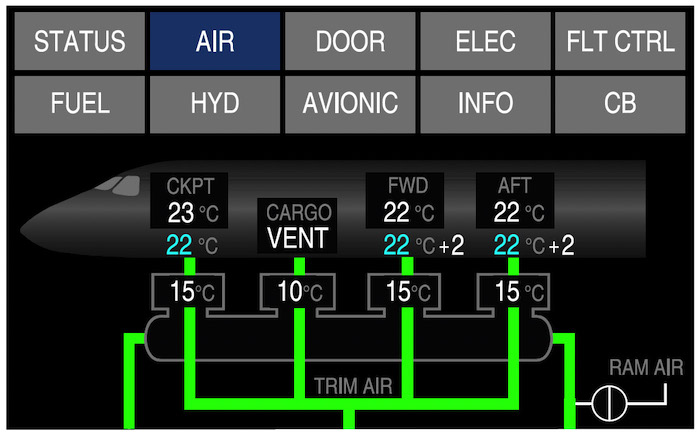
There are two safety valves on the aft pressure bulkhead. They have an overpressure and a negative pressure relief function determined by the pressure differential between the aircraft interior and the outside atmosphere. The safety valves operate _____and are completely independent of the other pressurization components.
The ram air ventilation is used to supply fresh air to the cabin and the flight compartment if both packs fail and cause unpressurized operation. The ram air ventilation is controlled by the RAM AIR guarded switch on the AIR panel.
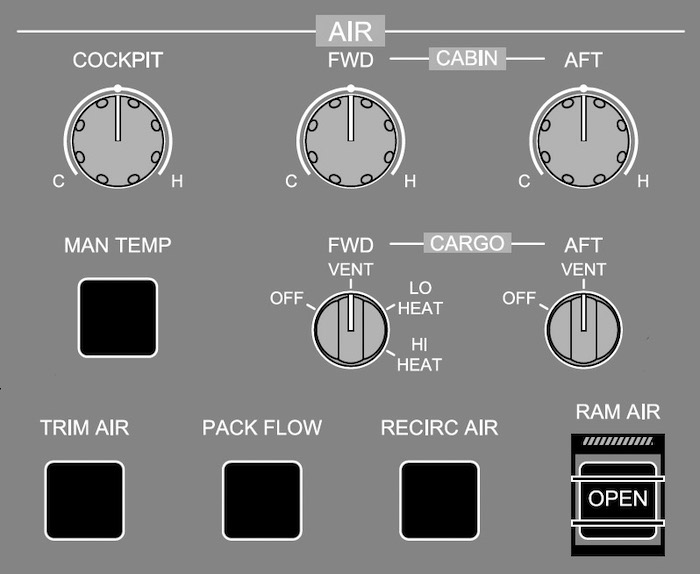
The Bleed Air Leak And Overheat Detection System (BALODS) protects the aircraft systems and structures by detecting bleed air leaks in the:
Dual independent heat detection loops run along the exterior of each manifold and in critical components such as the packs.
The APU supplies high-pressure bleed air:
Each cargo compartment (forward and aft) includes two cargo shutoff valves for ventilation. The two valves act as outflow valves. If smoke is detected in either cargo compartment, the associated valves close automatically.
One valve acts as an inflow valve, and the other as an outflow valve.
Advertisement
The pre-pressurization mode is activated on the ground when the thrust levers are advanced for takeoff. The Integrated Air System Controllers (IASCs) pressurize the aircraft to _____ airport elevation to eliminate any perceptible pressure changes at takeoff.
The ram air valve is not controlled by the DITCHING guarded switch. To close the ram air valve, the flight crew must manually select the RAM AIR switch, on the AIR panel, to OFF.
The cross-bleed valve is a butterfly valve that is operated by:
Butterfly valves are a family of quarter-turn rotational motion valves that are used in to shut-off flow. This valve isolates or connects the two sides of the bleed air manifold. It is normally controlled by the Integrated Air System Controllers (IASC) but can be manually selected open or closed with the XBLEED switch on the AIR panel.
FAIL is indicated for L BLEED and R BLEED switches. It indicates that the bleed air is not available when commanded by the Integrated Air System Controller (IASC). This can include the situations that follow:
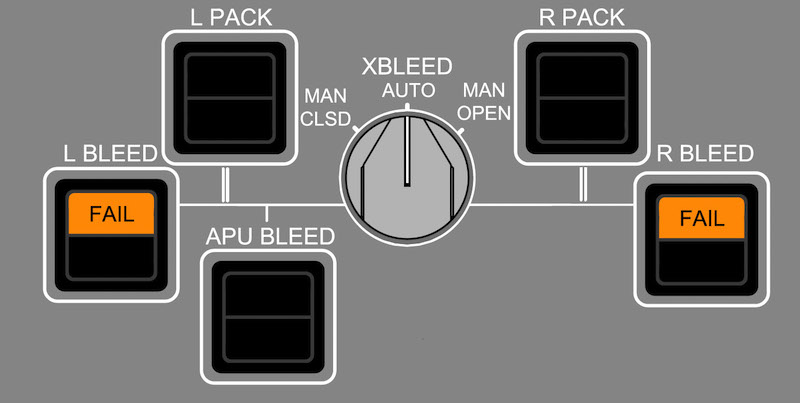
When does the Integrated Air System Controller (IASC) activate the descent mode?
The rate of cabin descent is directly related to the rate of descent of the aircraft. Cabin altitude descends on schedule until the cabin altitude is 300 feet below the landing elevation. During a high-speed descent, the cabin rate of descent is increased to match the remaining flight time.
When APU and engine bleed air are both available, the Integrated Air System Controller (IASC) will use engine bleed air during any of the following conditions:
Without external bleed air connected and while on BATT power only, it is possible that the EXT AIR symbol is displayed (green) on the AIR synoptic page while the L and R bleed pressure readouts can vary between 9 PSI and 16 PSI (instead of 0 PSI). This is because:
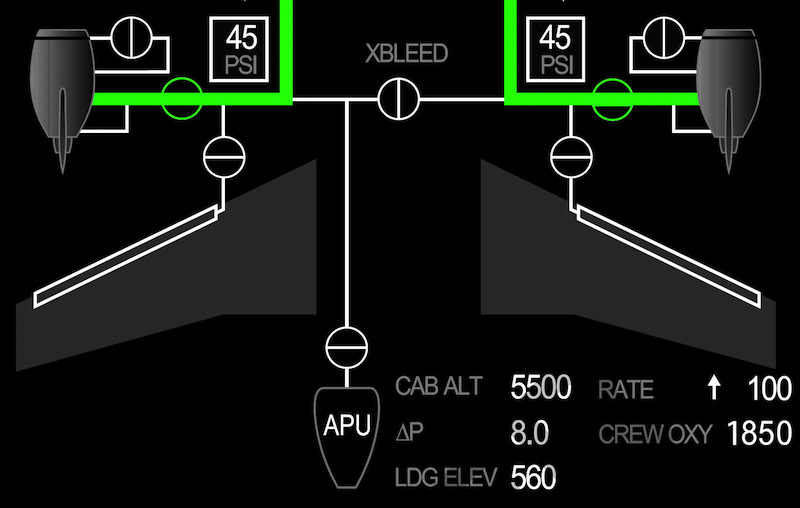
Recirculating air reduces the demand on the air-conditioning system and warms the cabin faster. Approximately _____ of cabin air is recirculated. A recirculation fan draws air through two recirculation filters and mixes it in the mix manifold with the conditioned air from the packs. The air is then redistributed back into the flight compartment and cabin zones.
In the cabin, the flight attendants can adjust the desired temperature by ____ from the pilot selection. The cabin temperature adjustment made by the flight attendants is displayed in white to the right side of the desired (pilot selected) zone temperature.
When the aircraft is on the ground, the ground valve installed on the skin on the lower right side of the fuselage opens and supplies additional cooling to the mid equipment bay if the Outside Air Temperature (OAT) is between 3 deg.C and 30 deg.C (37 deg.F and 86 deg.F). Before takeoff, the ground valve is closed by the IASC when all doors are closed and locked. At landing, the ground valve opens:
Advertisement
The packs default to the automatic mode when the FAIL and OFF labels are not illuminated on the PACK switches.
During______, the ozone catalytic converters reduce the ozone level of the bleed air before it flows into the air conditioning packs. This system is automatic and no input is necessary.
Bleed air from the APU enters the bleed air manifold through the APU bleed shutoff valve.
A one-way check valve downstream of the bleed valve prevents backflow to the APU. The IASC determines when the APU bleed is used in the pneumatic system
The four Pressure Equalization Valves (PEVs) prevent excessive pressure differential between the cabin and the cargo compartments. Each cargo compartment is equipped with large and small PEVs. The large PEVs prevent the cabin from pressurizing when a cargo door is not safely closed. The small PEVs equalize pressure between the cargo compartments and the cabin during fast climbs.
The bleed air from the Pressure Regulating Shutoff Valve (PRSOV) is cooled in the precooler with engine compressor.
The bleed air from the PRSOV is cooled in the precooler with engine fan air. The Bleed Temperature Sensor (BTS) downstream of the precooler lets the Integrated Air System Controllers (IASC) adjust the Fan Air Valve (FAV) to keep the engine bleed air temperature within limits.
As soon as_____, the takeoff mode is initiated and the system will begin a gradual cabin pressurization.
The aft cargo compartment is:
If only one Integrated Air System Controller (IASC) channel fails, the other channel takes control of the IASC functions and 'L AIR SYS CTLR FAIL' or 'R AIR SYS CTLR FAIL' caution message is displayed on the EICAS page.
If only one IASC channel fails, the other channel takes control of the IASC functions and the advisory message 'AIR SYSTEM FAULT' is displayed on the EICAS page. There is only a loss of redundancy for the IASC.
The trim air system supplies additional hot bleed air through four Trim Air Valves (TAVs). There is one TAV for each air-conditioned zone The additional hot bleed air is mixed with the cold air from the packs. These TAVs are also shown on the AIR synoptic page.
These TAVs are not shown on the AIR synoptic page.
The amber 'AUTO PRESS FAIL' caution message is displayed. What does it mean?
Advertisement
The precooler is a heat exchanger that uses engine fan air to cool engine air as it enters the bleed air manifold.
What does the red 'EQUIP BAY OVHT' warning message indicate?
The bleed air manifold routes bleed air to the pneumatic system. The left side of the manifold can be pressurized from the left engine, the APU, or the High Pressure Ground Connection (HPGC). The right engine normally supplies bleed air to the right side of the manifold.
A cross-bleed valve, normally controlled by the Integrated Air System Controllers (IASC), separates the bleed air manifold so that both sides of the manifold can be pressurized from a single source.
Two air-conditioning units (packs), installed in the wing-to-body fairing below the center wing box structure, supply source of cold air or hot air for the air-conditioning system.
It supplies only source of cold air. The bleed air enters the primary heat exchanger and is first cooled by external ram air. After it exits the primary heat exchanger, the bleed air is used to rotate the compressor/turbine assembly (air cycle machine) of the pack, and then it is returned to the secondary heat exchanger for additional cooling. After the second cooling, the bleed air is routed through the reheater, the condenser, and to the turbine, where it is cooled by expansion. The resulting cold air is sent to the duct for distribution
EQUIP COOLING - When VLV ONLY is selected:
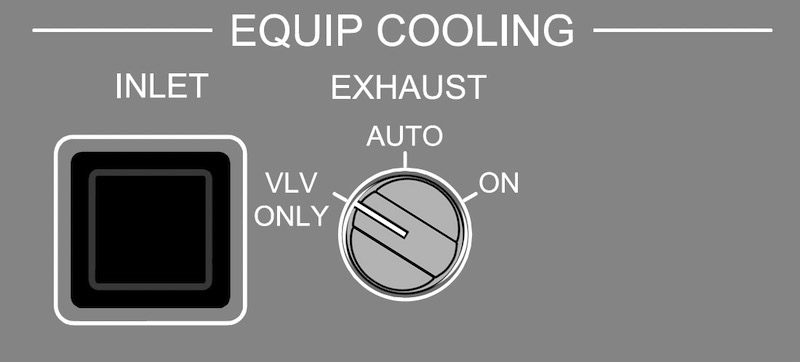
The two flow modes are automatic mode and high flow mode. In the automatic mode, the airflow is automatically adjusted by the IASCs based on the number of cabin occupants (passengers and cabin crew) entered in the FMS. If no cabin occupant data is entered in the FMS, the system assumes that the cabin is empty.
If no cabin occupant data is entered in the FMS, the system assumes that the cabin is full. A lower number of passengers will reduce the bleed flow consumption when maximum cooling and heating demand is not required. True.
Emergency depressurization is available in automatic and manual modes. When the EMER DEPRESS guarded switch is pushed in, the Outflow Valve (OFV) opens and the caution message 'EMER DEPRESS ON' is displayed on the EICAS page. When the EMER DEPRESS guarded switch is selected ON, the cabin will depressurize to:
A Trim Air Pressure Regulating Valve (TAPRV) regulates the _____ is required on the ground and also acts as a backup to the TAPRV.
FAIL is illuminated (amber) if APU bleed air is not available when commanded by the IASC. This can be caused by:
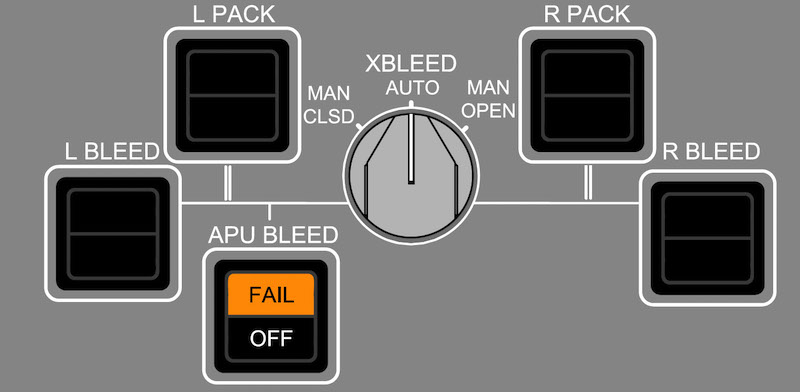
The Outflow Valve (OFV) controls the outflow of the cabin air, and it is located at the aft bottom of the aircraft.
The OFV is located at the mid bottom of the aircraft. The OFV, on the aft pressure bulkhead of the forward cargo compartment, controls the amount of air discharged from the aircraft to maintain a specific cabin pressure. This OFV has a butterfly valve that is electrically operated by an actuator.
Advertisement
The Bleed Temperature Sensor (BTS), downstream of the precooler, monitors engine bleed air temperature and sends the information to the Integrated Air System Controllers (IASC) to adjust the Fan Air Valve (FAV). The L BLEED OVHT or R BLEED OVHT caution message will be displayed on the EICAS page in case of:
Two Integrated Air System Controllers (IASCs) manage and control all the aircraft bleed valves. Each IASC has three channels: A channel, B channel, and a safety channel C. Channels A and B alternate control on a daily basis.
The High Pressure Ground Connection (HPGC) is located ______
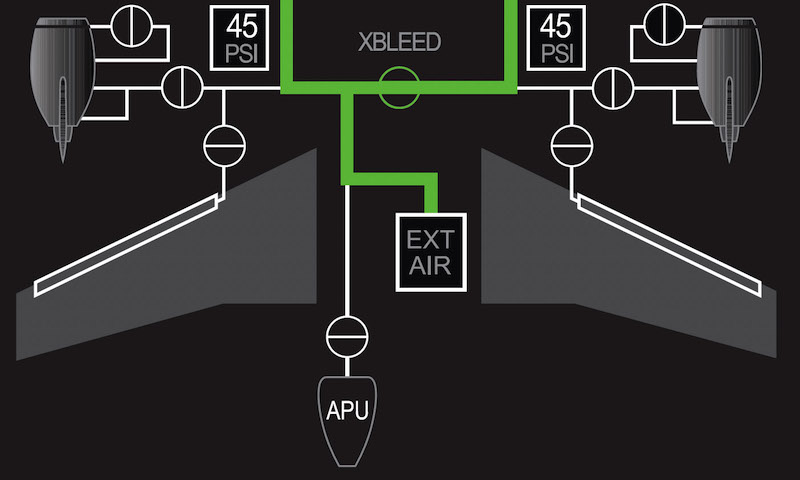
When high-pressure air is connected, EXT AIR and associated flow lines are displayed on the AIR synoptic page.
The cabin air distribution system supplies air at an optimal and consistent temperature throughout the four temperature zones. The cabin air is distributed from the distribution ducts and exhausted through the ceiling.
The cabin air is distributed from the distribution ducts and exhausted through the floor (not the ceiling).
